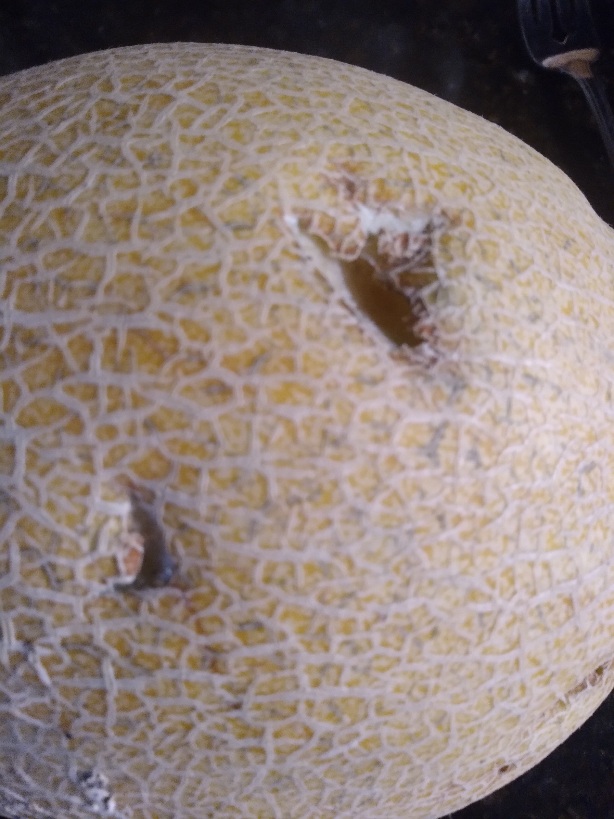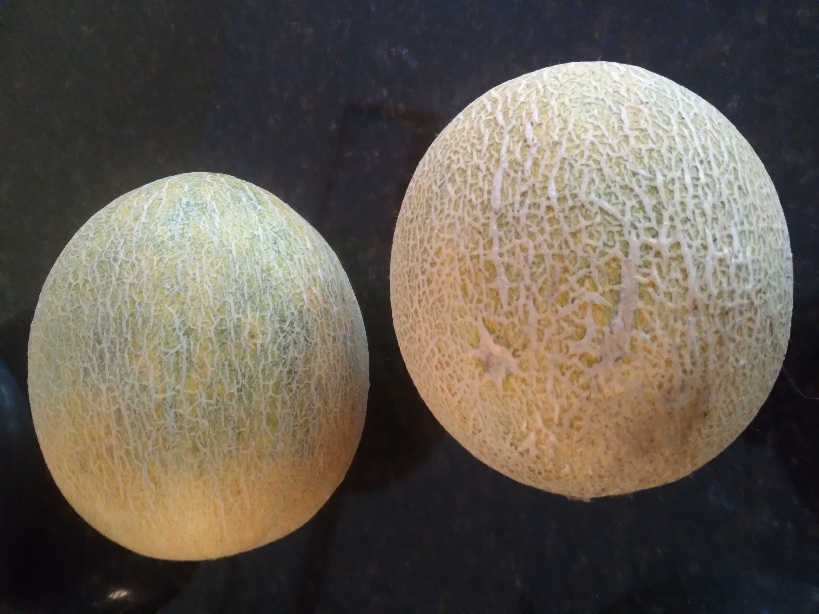When the opossums eat it, of course.
One of the first questions I had this summer about my new patch of cantaloupe growing in the raised bed garden was, “How to tell when cantaloupe is ripe? How do you know it’s time to pick it??”
Of course, I searched online for the answer. “It will smell musky.” Musky? What the heck does that even mean?
“It will separate easily from the vine.” Okay, that makes sense.
“The webbing will become pronounced.” Check.
I have another way to tell: when the opossums take bites out of it.

Growing Cantaloupe in the Backyard – Pests
My husband insists that the marks aren’t possum bites. We’ve had possums dig into our fruit before, and they leave distinctive crescent-shaped bite marks – and usually succeed in piercing the hard rind. He thinks it was the slugs in the raised bed that took these bites out of the fruit. Regardless of the pest that started eating the melon, I was able to salvage it before they ate through the rind. We enjoyed it last night. It was heavenly.
How to Tell When Cantaloupe Is Ripe
First, let’s unpack the advice I found online and the reality of how to tell when cantaloupe is ripe.
- It will smell musky: Yes, it actually does. I find the smell unpleasant. Ripe cantaloupe exudes a strong odor. It’s part melon scent and an almost sickly sweet, rotten smell. I think that’s what the experts dubbed “musky.” It definitely has a strong smell. I have two melons now on the kitchen counter and my whole kitchen smells like ripe cantaloupe.
- It will separate easily from the vine: This is a definite yes. The melons had already separate from the vine and were completely separated by the time I found them. An additional cantaloupe that I harvested yesterday just detached when I picked it up, like the fruit fell from the vine.
- The webbing becomes pronounced: The cantaloupe’s color changed from green to brownish tan to yellow tan in just a few days. It went from the brownish-tan color to yellow-tan in two days. We are experiencing a heatwave now, and I believe that hastened the ripening process.
Growing Cantaloupe in Containers versus Raised Bed Gardens
Lastly, another observation on the difference between growing cantaloupe in containers versus in the raised bed gardens.
The picture below shows two melons, both “Ambrosia” varieties started from plants purchased at the garden center.

Notice the difference? All of the melons I’m harvesting from the container-grown cantaloupes are smaller than the raised bed melons. The taste is the same. I am getting about twice as many melons from the plants grown in the raised bed in heavily amended soil. We added at least four inches of mushroom compost this year to the soil, and it has made all the difference in the vigor of the plants and the quality of the fruit.
The harvest this year has been abundant. We’ve canned over 60 pints of beets, dozens of beet and turnip greens, strawberry jam, and pickled peppers. Next up will be the tomatoes: we are starting to harvest them daily. We grew several beds of Roma tomatoes for sauce making. Our first batches will be pizza sauce and ketchup, followed by weekends filled with creating no-salt tomato sauce and canning it for the winter.
I love this time of year. The kitchen table is completely covered with produce harvested from my garden or the farmer’s market. The only exception is a plate of bananas, and if I could grow them at home, I would. Happy summer, happy gardening, all!





[…] It’s been 80 days and you can see all the beautiful melons in the garden. How do you know when it’s time to harvest cantaloupe? […]